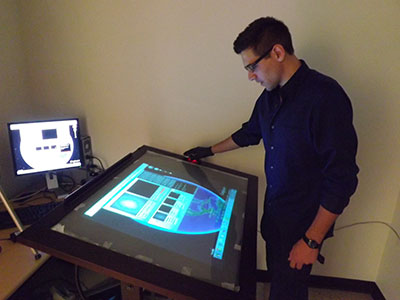
Miami senior touches up his psych skills with device creation

Psychology major David Gorley created a device that llustrates how multiple humans interact and coordinate behaviors when using technology
Written by Victoria Slater, CAS communication intern
While many students spend their summer vacations playing on their various touch-screen contraptions, Miami University senior David Gorley decided to make one. For the past year, the psychology major with an entrepreneurship minor has been dedicating days and nights to the creation of his Multi-Touch Device, a kind of giant interactive track pad that serves to connect humans to a virtual world.
The Multi-Touch Device — which is now in its 15th iteration —stemmed from an inspirational TED talk by Pranav Mistry, the inventor of the wearable SixthSense device.
“I was watching TED Talks and came across this one video that really inspired me,” Gorley said. “I’ve always kind of been like a hacker, a tinkerer. I’ve always loved taking stuff apart, building stuff, designing stuff.”
Gorley began the project by collecting a plethora of random items he encountered on campus, everything from leftover construction equipment to pieces of trash.
“Before we had all of this nice equipment, thanks to Miami University, the first several prototypes were essentially made out of garbage that I found on the street,” Gorley said. “I would just drive around and pick up windows and plywood and build these different things out of stuff that was just lying around.”
The design underwent 12 prototypes before it was introduced to a fellow student in Gorley’s ecology psych lab, and Miami has now expanded the project’s research with further funding. Psychology graduate student Henry Cook, who works besides Gorley in the lab, said they were interested in learning about several different components when crafting the device.
“We are interested in looking at adaption, coordination, and tasks and strengths, how behavior is adapted, and how patterns emerge from the coupling of different components,” Cook said.
Psychology professor Leonard “Jay” Smart, who oversees Gorley and his project, said the goal of the device is to illustrate how multiple humans interact and coordinate behaviors when using technology.
“The nice thing about having a device with a big size is that you can have more than one person interact with it,” Smart said. “You can do all sorts of coordination tasks, trying to figure out how to work together. And particularly with a new interface like this, you have to figure out how you behave and then how the other person behaves as well.”
Smart said the device now easily relates to the purpose of the ecological psych lab, especially with its interactive qualities and applicability to the direction in which computer technology is heading.
“It doesn’t really divert from the purpose of the lab, which supports a lot of ideas,” Smart said. “The device is very timely, and that’s where technology is going with this idea of moving away from the mouse and clicking. Interaction has become more important, particularly because nowadays most technology isn’t focused on just one person but on a team.”
As a graduating senior, Gorley will not see his device through its completion, but he feels proud of the work he has accomplished as he explores some newfound post-graduation opportunities.
“I still kind of see it as my baby,” he said. “It now has much greater potential, and having the opportunity to start this project and see it come to fruition was a good way to discover myself and find confidence.”
